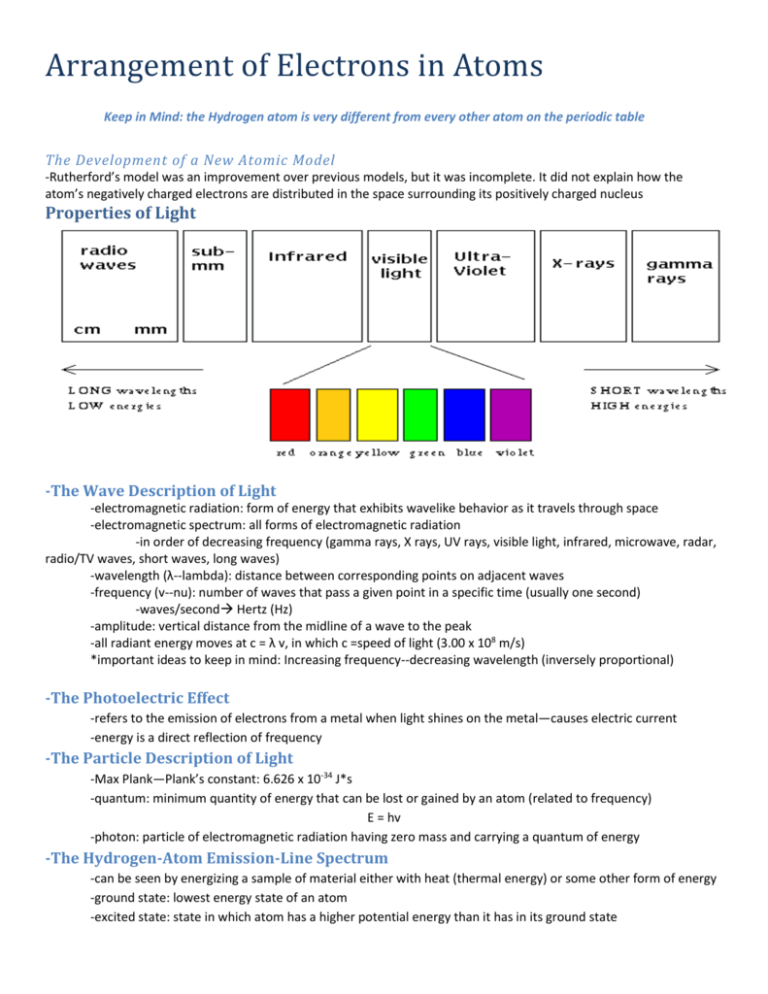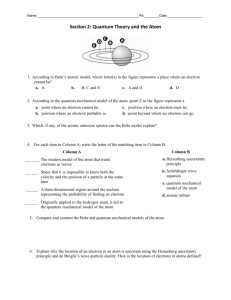The Quantum Model
advertisement

Arrangement of Electrons in Atoms Keep in Mind: the Hydrogen atom is very different from every other atom on the periodic table The Development of a New Atomic Model -Rutherford’s model was an improvement over previous models, but it was incomplete. It did not explain how the atom’s negatively charged electrons are distributed in the space surrounding its positively charged nucleus Properties of Light -The Wave Description of Light -electromagnetic radiation: form of energy that exhibits wavelike behavior as it travels through space -electromagnetic spectrum: all forms of electromagnetic radiation -in order of decreasing frequency (gamma rays, X rays, UV rays, visible light, infrared, microwave, radar, radio/TV waves, short waves, long waves) -wavelength (λ--lambda): distance between corresponding points on adjacent waves -frequency (v--nu): number of waves that pass a given point in a specific time (usually one second) -waves/second Hertz (Hz) -amplitude: vertical distance from the midline of a wave to the peak -all radiant energy moves at c = λ v, in which c =speed of light (3.00 x 108 m/s) *important ideas to keep in mind: Increasing frequency--decreasing wavelength (inversely proportional) -The Photoelectric Effect -refers to the emission of electrons from a metal when light shines on the metal—causes electric current -energy is a direct reflection of frequency -The Particle Description of Light -Max Plank—Plank’s constant: 6.626 x 10-34 J*s -quantum: minimum quantity of energy that can be lost or gained by an atom (related to frequency) E = hv -photon: particle of electromagnetic radiation having zero mass and carrying a quantum of energy -The Hydrogen-Atom Emission-Line Spectrum -can be seen by energizing a sample of material either with heat (thermal energy) or some other form of energy -ground state: lowest energy state of an atom -excited state: state in which atom has a higher potential energy than it has in its ground state *there are many possible excited states, each with a unique energy, but only one ground state energy for atoms of a given element -emission-line spectrum: a diagram or graph that indicates the degree to which a substance emits radiant energy with respect to wavelength -can be continuous (spectra of sun and heated solid) or line spectra (gaseous phase spectra) -Lyman (ultraviolet), Balmer (visible), and Paschen (infrared) series of spectral lines -Bohr Model of the Hydrogen Atom -electron can circle the nucleus only in allowed paths, or orbits, which have a fixed radius and energy -lowest energy state found in orbitals closest to nucleus -when an electron falls to a lower energy level, a photon is emitted, and the process is called emission -energy must be added to an atom in order to move an electron from a lower energy level to a higher energy level—absorption -Bohr’s model only explains spectral lines of HYDROGEN The Quantum Model of the Atom Electrons as Waves -light and atoms possess a “dual wave—particle” nature -DeBroglie suggested that electrons should be considered as waves confined to the space around the atomic nucleus -diffraction: bending of a wave as it passes by the edge of an object or through a small opening -interference: occurs when waves overlap—overlapping results in reduction of energy in some areas and an increase in others -electron density: gives the probability that an electron will be found in a particular region of the atom The Heisenberg Uncertainty Principle: -it is impossible to determine simultaneously both the position and velocity of an electron or any other particle The Schrodinger Wave Equation -quantum theory: describes mathematically the wave properties of electrons and other small particles -solutions to the Schrodinger wave equations give only the probability of finding an electron at a given point -orbital: three-dimensional region around the nucleus that indicates the probable location of an electron Atomic Orbitals and Quantum Numbers -according to the Schrodinger equation, electrons in atomic orbitals have quantized energies -quantum numbers: specify the properties of atomic orbitals and the properties of electrons in orbitals Principle Quantum Number (n) -indicates the main energy level occupied by the electron -the total number of orbitals that can exist in a given shell, or main energy level, is equal to n2 Angular Momentum Quantum Number (l) -indicates the shape of the orbitals -number of orbital shapes is equal to n -value of l allowed are zero and all positive integers ≤ n-1 -four sublevels: s,p,d,f Magnetic Quantum Number (m) -indicates the orientation of an orbital around the nucleus -values are whole numbers (including zero) from –l to +l Spin Quantum Number -indicate the two fundamental spin states of an electron in an orbital (accounts for magnetic properties of atom) - +1/2 and -1/2 orbital sublevels s p d f angular momentum l=0 l=1 l=2 l=3 n (energy shell) 1 2 3 4 # electrons per shell (2n2) 2 8 18 32 # orbitals within shell (n2) 1 4 9 16 Electron Configurations -electron configurations: arrangement of electrons in an atom unique for each element -ground-state electron configuration: lowest energy arrangement of the electrons for each element -highest occupied energy level: electron-containing main energy level with the highest principle quantum number -inner shell electrons: electrons that are not in the highest-occupied energy level *each orbital can be occupied by a maximum of 2 electrons, and they must have opposite spin states. *In a hydrogen atom, the energy of the electron depends only on its principle quantum number n. In a many-electron atom, the energy of an electron depends on both n and its angular momentum quantum number, l. *For electrons of the same principal quantum number, their penetrating power or proximity to the nucleus, decreases in the order s>p>d>f. This means that, for example, more energy is required to separate a 3s electron from a manyelectron atom than is required to remove a 3p electron. Rules Governing Electron Configuration 1. Order: Aufbau Principle: an electron occupies the lowest-energy orbital that can receive it 2. Pauli-exclusion Principle: no two electrons in the same atom can have the same set of four quantum numbers 3. Hund’s Rule: orbitals of equal energy is each occupied by one electron before any orbital is occupied by a second electron, and all electrons in singly occupied orbitals must have the same spin state ↑↓ ↑__ ↑__ -The most stable arrangement of electrons in a subshell is one that has the greatest number of parallel spins. -paramagnetic: atoms in which one or more electrons are unpaired -diamagnetic: atoms in which all the electron spins are paired Representing Electron Configurations Three types of Notation 1. Orbital notation: an unoccupied orbital is represented by a line, ____, with the orbital’s name written underneath the line. (uses arrows to show spin state) H ↑ 1s1 He ↑↓ 1s2 Li ↑↓ ↑↓ 1s2 2s1 2. Electron configuration notation: number of electrons in a sublevel is shown by adding a superscript to the sublevel designation Hydrogen (1s1) Helium (1s2) 3. Noble gas notation: using the chemical symbols for the group 18 elements as a shorthand for electron configuration a. Noble gas configuration: an outer main energy level occupied, in most cases, by 8 electrons (octet) Review Questions 1. List five example of electromagnetic radiation. What is the speed of all forms of electromagnetic radiation in a vacuum? 2. What are the frequency and wavelength ranges of visible light? 3. List the colors of light in the visible spectrum in order of increasing frequency. 4. How are the wavelength and frequency of electromagnetic radiation related? How are energy and frequency related? How are the energy and wavelength of electromagnetic radiation related? 5. Describe the photoelectric effect. 6. Distinguish between the ground state and an excited state of an atom. 7. According to Bohr’s model of the hydrogen atom, how is the hydrogen’s emission spectrum produced? 8. Describe two major shortcomings of Bohr’s model of the atom. 9. a. What is the principle quantum number? b. How is it symbolized? c. What are shells? d. How does n relate to the number of electrons allowed per main energy level? 10. What information is given by the angular momentum quantum number? What are sublevels, or subshells? 11. For each of the following values of n, indicate the numbers and types of sublevels possible for that main energy level. a. n = 1 b. n = 2 c. n = 3 d. n = 4 e. n = 7 (number only) 12. What information is given by the magnetic quantum number? 13. How many orbital orientations are possible in each of the s, p, d, and f sublevels. Explain this. 14. What is the relationship between n and the total number of orbitals in a main energy level? -How many total orbitals are contained in the third main energy level? In the fifth? 15. What information is given by the spin quantum number? What are the possible values for this quantum number? 16. How many electrons could be contained in the following main energy levels with n equal to the number provided? a. 1 b. 3 c. 4 d. 6 e. 7 17. Sketch the shape of an s orbital and a p orbital. 18. How does a 2s orbital differ from a 1s orbital? 19. How do a 2px and 2py orbital differ? 20. In your own words, state the Aufbau principle. Explain what this means for the electron. 21. State Hund’s rule in your own words. What is the basis for this rule? 22. In your own words, state the Pauli exclusion principle. 23. What is the significance of the spin quantum number? 24. What is meant by the highest occupied energy level in an atom? What are inner shell electrons? 25. Determine the highest occupied energy level in the following elements: a. He b. Be c. Al d. Ca e. Sn 26. Write the orbital notation for the following elements. a. P b. B c. Na d. O 27. Write the electron-configuration notation for the element whose atoms contain the following number of electrons: a. 3 b. 6 c. 8 d. 10 28. Given that the electron configuration for oxygen is 1s22s22p4, answer the following questions: a. How many electrons are in each oxygen atom? b. What is the atomic number of this element? c. Write the orbital notation for oxygen’s electron configuration. d. How many unpaired electrons does oxygen have? e. What is the highest occupied energy level? f. How many inner-shell electrons does the atom contain? g. In which orbital(s) are these inner-shell electrons located? 29. What are the noble gases? What is a noble-gas configuration? How does noble-gas notation simplify writing an atom’s electron configuration? 20.Write the noble-gas notation for the electron configuration of each of the elements below. a. Cl b. Ca c. Se 21. What information is given by the noble-gas notation [Ne]3s2? What element does this represent? 22.Write both the complete electron-configuration notation and the noble-gas notation for each of the elements below. a. Na b. Sr c. P 23. Identify each of the following atoms on the basis of its electron configuration: a. 1s22s22p1 b. 1s22s22p5 c. [Ne]3s2 d. [Ne]3s23p2 e. [Ne]3s23p5 f. [Ar]4s1 g. [Ar]3d64s2 24. List the order in which orbitals generally fill, from 1s to 7p orbital. 25. Write the noble-gas notation for the electron configurations of each of the following elements: a. As b. Pb c. Lr d. Hg e. Sn f. Xe g. La








